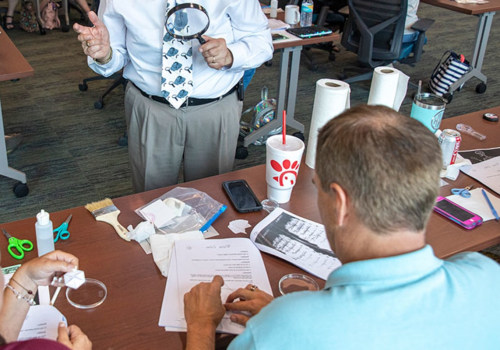Life Science Lesson Plans for 6-8 Learners
Life Science Lesson Plans for grades 6-8 engage learners through hands-on activities, exploring concepts such as ecosystems, biodiversity, and genetics. Lessons incorporate real-world applications, like analysing local pollution impacts and growing plants under varied conditions, to improve understanding. Inquiry-based approaches encourage critical thinking and scientific reasoning. Practical activities, supported by technology such as virtual simulations, maintain student engagement and offer interactive learning experiences. Expanding your knowledge with these tools and strategies can enrich your teaching.
Key Points
- Integrate hands-on activities like creating food webs to teach energy flow in ecosystems.
- Use inquiry-based learning to engage students in formulating hypotheses and conducting experiments.
- Implement real-world applications such as analyzing local ecosystem data for critical thinking.
- Organize field trips to local parks for practical ecosystem investigation and biodiversity study.
- Develop interactive lessons using technology, like virtual simulations, to enhance understanding of life science concepts.
Understanding Key Life Science Concepts
How does one begin to unravel the complexity of life science? By delving into its foundational concepts.
Understanding life science requires exploring the intricate relationships within ecosystems, where energy flows and biodiversity thrives. Evolution provides insight into how organisms adapt over time, while homeostasis guarantees their internal stability.
These concepts—cell theory, genetics, energy transfer, and environmental impacts—are not isolated; they interconnect, forming a cohesive framework necessary for comprehending life.
Educators can guide students in grasping these principles, emphasizing the interplay between organisms and their surroundings, ultimately fostering an appreciation for the delicate balance sustaining life on Earth.
Engaging Activities for Hands-On Learning
Investigating foundational life science concepts lays the groundwork for understanding the world, and engaging activities can improve this learning experience by making abstract ideas tangible.
Hands-on activities enable students to investigate biology and ecosystems effectively. For instance, experiments with celery help students understand plant biology and water absorption. Simulating life cycles, such as butterflies, engages students in developmental stages.
Field trips to parks offer real-world experiences to investigate ecosystems. Creating cell models aids in understanding cellular structures. Developing food webs in class illustrates energy flow and interdependent relationships among organisms.
- Conduct celery experiments
- Simulate butterfly life cycles
- Organize field trips
- Create cell models
- Develop classroom food webs
Exploring Ecosystems and Biodiversity
When studying ecosystems, it is important to understand the intricate relationships between living organisms and their physical environments. Ecosystems, composed of biotic and abiotic factors, foster complex interactions that sustain life.
Biodiversity, or the variety of species within these ecosystems, plays a significant role in resilience and adaptation to environmental changes. Food webs demonstrate how energy flows among species, from producers to consumers and decomposers.
Human activities, such as deforestation, impact biodiversity, leading to habitat destruction. Conservation strategies are critical for preserving biodiversity. Protected areas and sustainable practices help maintain healthy ecosystems and support the environment's overall well-being.
Integrating Inquiry-Based Learning Approaches
Inquiry-based learning in life science education represents a dynamic approach to teaching that encourages students to actively participate in the scientific process. This method fosters critical thinking by enabling students to investigate ecosystems through hands-on activities and investigations.
By engaging in inquiry-based tasks, students learn to formulate hypotheses, conduct experiments, and understand complex life science concepts like genetics and ecology. Integrating this approach within the curriculum supports education standards, promoting collaborative learning environments.
- Encourages asking questions and forming hypotheses
- Provides hands-on activities like plant growth observation
- Focuses on real-world ecosystem investigations
- Improves critical thinking and scientific reasoning
- Aligns with educational standards for student-centered learning
Utilizing Real-World Applications in Lessons
Incorporating real-world applications into life science lessons bridges the gap between theoretical knowledge and practical experience, enhancing student engagement and understanding.
By incorporating activities like investigating local ecosystems, students engage with the science behind their own environments, fostering a deeper connection to the material.
Projects such as analyzing pollution's impact on nearby rivers employ real data, encouraging critical thinking and problem-solving.
Hands-on activities, like growing plants under varied conditions, allow students to observe biological principles firsthand.
Additionally, technology such as virtual simulations of genetic experiments provides interactive opportunities to examine complex topics, making science relatable and applicable to everyday life.
Resources and Tools for Effective Teaching
A diverse array of resources and tools is available to educators aiming to improve the effectiveness of their life science teaching.
Interactive materials, including simulations and virtual field trips, offer experiential learning to engage students with life science concepts. Hands-on activities, such as growing bacteria or conducting plant biology experiments, foster critical thinking.
Technology tools, like multimedia resources and educational apps, cater to diverse learning styles, making complex concepts accessible. Collaborative projects, such as developing food webs, augment teamwork and engagement.
Formative assessment techniques provide timely feedback, allowing educators to tailor instruction to meet students' needs.
- Simulations and virtual field trips
- Hands-on experiments
- Multimedia resources and apps
- Collaborative projects
- Formative assessment techniques
Frequently Asked Questions
What Are Some Strategies for Differentiating Instruction in Life Science Lessons?
Differentiating instruction entails using varied teaching methods, such as hands-on activities, visual aids, and technology integration, to cater to diverse learning styles. Encouraging collaboration and providing tiered assignments can foster inclusivity and improve understanding for all students.
How Can I Assess Student Understanding Effectively in Life Science Topics?
Evaluating student understanding can be achieved through formative assessments like quizzes, discussions, and projects. Incorporating peer evaluations and self-assessments fosters reflection and accountability, ensuring learners grasp life science concepts while promoting their growth and development.
What Are the Best Practices for Integrating Technology in Life Science Education?
Integrating technology in life science education involves utilizing interactive simulations, virtual labs, and digital collaboration tools. These resources improve engagement, foster deeper understanding, and provide opportunities for students to investigate real-world applications, ultimately serving diverse learning needs effectively.
How Can I Incorporate Culturally Relevant Content Into My Life Science Curriculum?
Incorporating culturally relevant content involves acknowledging diverse perspectives, using examples from various cultures, and highlighting contributions from underrepresented groups. This approach fosters inclusivity, encourages student engagement, and helps learners plunge into life science concepts to their communities.
What Resources Are Available for Supporting Students With Special Needs in Life Science?
Educators seeking to support students with special needs in life science can access adaptive lesson plans, sensory-friendly materials, and assistive technologies. These resources aim to create inclusive learning environments, fostering understanding and engagement for all students.
Final Thoughts
Life Science lesson plans for middle school learners are instrumental in developing a deep understanding of biological concepts, fostering curiosity and critical thinking. By incorporating engaging activities and real-world applications, educators can effectively convey the complexities of ecosystems and biodiversity. These plans emphasize inquiry-based learning, encouraging students to investigate and ask questions. With access to diverse resources and tools, teachers are well-prepared to deliver content in both classroom and online settings, ensuring a thorough educational experience.

Teach Science Online with Spires Online Tutors
Work with UK and international students across IGCSE, GCSE, A-Level, IB, AP, KS3, university, postgraduate, and admissions tutoring — including Oxbridge prep. Students for Biology, Chemistry, Physics, and all STEM subjects are looking for professional, experienced tutors.
Find Online Tutoring Jobs






